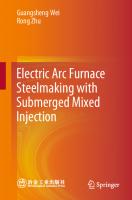Ionization and Absorption Effects in the Electric Furnace
330 50 506KB
English Pages 3 Year 1922
Recommend Papers
File loading please wait...
Citation preview
VOL. 8, 1922
PHYSICS: A. S. KING
123
The records in figures 9 and 10 contain an almost complete example of a free nodal region sustaining itself ZR = 24 cm. above the table, and figure 8 gives the acoustic pressures within it. These are largest near the pipe, though not quite symmetric and it is possible that the direct ray may here influence the resonator, In general, however, i.e., at greater distances, the direct ray is relatively ineffective and it is to the occurrence of nodal regions alone that the resonator then responds, even when the direct ray would seem to have the advantage of nearness. Thus in figure 10, the curve for r = 0, when tested at the second antinodal plane (ZR = 36 cm.), although the pipe is now but 12 cm. away, nevertheless retains the features of a pronounced minimum. * Advance note from a Report of the Carnegie Inst., of Washington, D. C.
IONIZATION AND ABSORPTION EFFECTS IN THE ELECTRIC FURNACE By ARTHUR S. KING MOUNT WILSON OBSERVATORY, CARN1GIP INSTITUTION OF WASHINGTON Communicated April 8, 1922
In 1914, the publication by Fowler of the series formulae for enhanced lines showed that the Rydberg constant "N," occurring in the formulae for arc lines, is changed to 4N for enhanced lines. This established the view based on a very general difference of behavior in both laboratory and celestial sources, that the enhanced lines and the arc lines arise from differently constituted emitting centers. The condition pictured by Bohr's theory is that the enhanced lines are produced by atoms which have lost one electron, while the normal atom emits the arc lines. Recent work by Saha applies the relations recognized in physical chemistry to the case when the normal atom is changed into an ionized atom with an electron set free. A definite equilibrium is considered as established, represented in the case of calciunm by Ca=Ca+ + e. It follows from this that if we add a large supply of electrons from some substance which becomes ionized more readily than calcium, fewer electrons from the calcium can exist in the free state, and the proportion of Ca+ atoms becomes less, with a corresponding weakening of the enhanced lines relative to the lines of the normal atom. In the electric furnace, the enhanced lines of some substances can be produced faintly, and the effect of a mixture with an easily ionized substance may be tested, under the same conditions of temperature and pressure for the mixture as for the pure substance. Experiments have been
124
PHYSICS: A. S. KING
PROC. N. A. S.
carried out in which both emission and absorption spectra were compared in this way. The spectra of calcium and strontium showed in each case a decided weakening of the enhanced lines when a mixture of either element with potassium or caesium was examined, while the arc lines, presumably due to the unionized atoms, were unaffected. Barium, with a smaller difference between its ionizing potential and that of the added substance, showed a less pronounced effect. Sodium, whose ionization potential is nearly the same as that of barium, produced no weakening of the barium enhanced lines. The experiments thus support- the view of an equilibrium between electrons and ionized atoms, which may be disturbed by an added supply of electrons. Certain features of absorption spectra may be described briefly. By holding the furnace at a measured temperature and passing through the tube a beam of white light from a tungsten filament the absorption spectrum may be readily produced. Turning off the lamp enables the emission spectrum of the vapor at the same temperature to be photographed for comparison. The iron spectrum under these conditons showed no decided difference in emission and absorption except as to the production of the ultra-violet spectrum. The low temperatuire stage (160O0-1700° C.) ended in emission at X 3440, except that a few scattered lines as far as X 3000 could be brought out faintly. The continuous spectrum when a plug is used in the tube at the same temperature has about the same limit, and it has been a general experience that the emission of vapors in the furnace extends no farther than the spectrum of a black body at the same temperature. The possibility remained that metallic vapor too cool to emit in the far ultra-violet could still show absorption lines if a sufficiently hot source of white light in a chamber transparent to the ultra-violet were available. Lacking such a source, the light from exploding wires was tried, which Anderson has shown to give a continuous spectrum extending to short wave-lengths. Dr. Anderson kindly operated the explosion apparatus for this experiment, the best results being obtained with wires of lead. With the furnace temperature as low as 16000 C., absorption lines of iron could be identified as far as X 2298, a limit set by the sensitiveness of the photograhic emulsion. These lines had previously been obtained as far as X 2447 in the high temperature furnace when the continuous spectrum was supplied by a graphite plug in the tube. We thus have the condition that for the emission spectrum a definite limit is set by the black body radiation at that temperature, but that the vapor is able to absorb radiation of much shorter wave-length. One feature of Saha's theory is that a vapor too cool to emit should be able to absorb the lines of the principal series. This was tried with the
Vo., 8, 1922
PA THOLOGY: PEARL AND BACON
125
strong flame lines XX 4227, 4607, and 5535 of calcium, strontium, and barium, respectively. In each case a temperature was found at which no emission could be detected, but when white light was sent through the furnace the lines appeared distinctly in absorption. For these favorable lines, the view of Saha is thus confirmed. It will be of interest to test other series lines in the same way. In previous investigations on the absorption of vapors of the alkali metals, the lines of the principal series have appeared, but not those of the subordinate series. Since in emission spectra the latter require higher temperatures than the principal series lines, it seemed probable that a relatively high temperature was required to produce them in absorption. Experiment showed this to be the case. Sodium, potassium, caesium, and rubidium were tested by heating to a high temperature in a tube having a plug to give the continuous ground. The subordinate series lines appeared in absorption for each element. The general character of the absorption phenomena in the furnace may be described as in general a reversal, when white light is passed through the tube, of the emission spectrum at the same, temperature. Exceptions are found in the easily excited principal series lines and perhaps others, which the vapor can absorb before it emits, and in the ultra-violet region beyond the limit, at the given temperature, of the black-body radiation. In the latter case an absorption spectrum appears beyond the emission limit when a sufficiently hot source of white light is employed.
PRELIMINARY NOTE ON A BIOMETRICAL STUDY OF THE RELA TIONS OF CERTAIN VISCERA IN TUBERCULOSIS' BY RAYMOND PIARL AND AGNZS LATIMER BACON SCHOOL OP HYGIPNU AND PUBLIc HEALTH, JOHNS HOPKINS UNIVERSITY Communicated May 4, 1922
One of the most fundamental problems of biology is that of adaptive regulation to the end of maintaining the life of the individual. The ability to readjust the functional relations of the parts of the organism, after they have been in any way disturbed is widespread among living things generally, including man. A well-known example is seen in the functional hypertrophy of the kidney. If one kidney is removed the remaining one promptly enlarges and carries on the work formerly divided between the two. Many similar examples might be cited. We have been engaged for the past year in a study of this phenomenon of adaptive functional regulation from a somewhat new point of view. Starting from the justifiable assumption that the records of pathological anatomy, as set down in autopsy protocols, should if adequately analyzed
![[Article] A Study of Absorption Spectra with the Electric Furnace](https://ebin.pub/img/200x200/article-a-study-of-absorption-spectra-with-the-electric-furnace.jpg)



![Metals and the Skin: Topical Effects and Systemic Absorption [3ed]
0824793854, 9780824793852, 9780585385389](https://ebin.pub/img/200x200/metals-and-the-skin-topical-effects-and-systemic-absorption-3ed-0824793854-9780824793852-9780585385389.jpg)

![[Article] A Study of the Effect of a Magnetic Field on Electric Furnace Spectra](https://ebin.pub/img/200x200/article-a-study-of-the-effect-of-a-magnetic-field-on-electric-furnace-spectra.jpg)


![[Article] An Attempt to Detect the Mutual Influence of Neighboring Lines in Electric Furnace Spectra Showing Anomalous Dispersion](https://ebin.pub/img/200x200/article-an-attempt-to-detect-the-mutual-influence-of-neighboring-lines-in-electric-furnace-spectra-showing-anomalous-dispersion.jpg)
